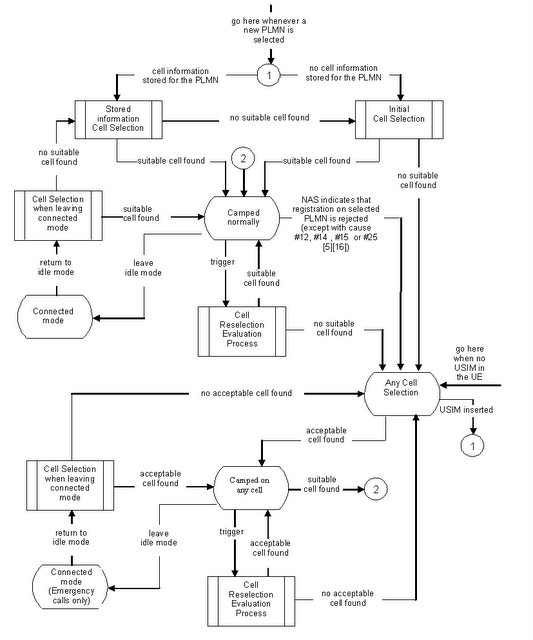The principles of PLMN selection in [amazon_link id=”012385489X” target=”_blank” ]E-UTRA[/amazon_link] are based on the 3GPP PLMN selection principles. Cell selection is required on transition from EMM_DETACHED to EMM-REGISTERED and from ECM-IDLE or ECM-CONNECTED.
Cell selection
- The UE NAS layer identifies a selected PLMN and equivalent PLMNs
- The UE searches the E-UTRA frequency bands and for each carrier frequency identifies the strongest cell. It reads cell system information broadcast to identify its PLMN(s)
- The UE may search each carrier in turn (“initial cell selection”) or make use of stored information to shorten the search (“stored information cell selection”).
- The UE seeks to identify a suitable cell; if it is not able to identify a suitable cell it seeks to identify an acceptable cell. When a suitable cell is found or if only an acceptable cell is found it camps on that cell and commence the cell reselection procedure
- A suitable cell is one for which the measured cell attributes satisfy the cell selection criteria; the cell PLMN is the selected PLMN, registered or an equivalent PLMN; the cell is not barred or reserved and the cell is not part of a tracking area which is in the list of “forbidden tracking areas for roaming”
- An acceptable cell is one for which the measured cell attributes satisfy the cell selection criteria and the cell is not barred
- Evolved Universal Terrestrial Radio Access (E-UTRA) and Evolved Universal Terrestrial Radio Access Network
(E-UTRAN); Overall description; Stage 2: 3GPP TS 36.300 - Evolved Universal Terrestrial Radio Access (E-UTRA); User Equipment (UE) procedures in idle mode : 3GPP TS 36.304
The NAS can control the RAT(s) in which the cell selection should be performed, for instance by indicating RAT(s) associated with the selected PLMN, and by maintaining a list of forbidden registration area(s) and a list of equivalent PLMNs. The UE shall select a suitable cell based on idle mode measurements and cell selection criteria.
Transition to RRC_IDLE
On transition from RRC_CONNECTED to RRC_IDLE, a UE should camp on the last cell for which it was in RRC_CONNECTED or a cell/any cell of set of cells or frequency be assigned by RRC in the state transition message.
Recovery from out of coverage
The UE should attempt to find a suitable cell in the manner described for stored information or initial cell selection above. If no suitable cell is found on any frequency or RAT the UE should attempt to find an acceptable cell.

Cell Selection Process
Initial Cell Selection
This procedure requires no prior knowledge of which RF channels are E-UTRA carriers. The UE shall scan all RF channels in the E-UTRA bands according to its capabilities to find a suitable cell. On each carrier frequency, the UE need only search for the strongest cell. Once a suitable cell is found this cell shall be selected.
Stored Information Cell Selection
This procedure requires stored information of carrier frequencies and optionally also information on cell parameters, from previously received measurement control information elements or from previously detected cells. Once the UE has found a suitable cell the UE shall select it. If no suitable cell is found the Initial Cell Selection procedure shall be started.
Cell Selection Criterion
The cell selection criterion S is fulfilled when:
Srxlev > 0 AND Squal > 0
Where:
| Srxlev = Qrxlevmeas – (Qrxlevmin + Qrxlevminoffset) – Pcompensation |
| Squal = Qqualmeas – (Qqualmin + Qqualminoffset) |
Where:
| Srxlev | Cell selection RX level value (dB) |
| Squal | Cell selection quality value (dB) |
| Qrxlevmeas | Measured cell RX level value (RSRP) |
| Qqualmeas | Measured cell quality value (RSRQ) |
| Qrxlevmin | Minimum required RX level in the cell (dBm) |
| Qqualmin | Minimum required quality level in the cell (dB) |
| Qrxlevminoffset | Offset to the signalled Qrxlevmin taken into account in the Srxlev evaluation as a result of a periodic search for a higher priority PLMN while camped normally in a VPLMN |
| Qqualminoffset | Offset to the signalled Qqualmin taken into account in the Squal evaluation as a result of a periodic search for a higher priority PLMN while camped normally in a VPLMN |
| Pcompensation | max(PEMAX –PPowerClass, 0) (dB) |
| PEMAX | Maximum TX power level an UE may use when transmitting on the uplink in the cell (dBm) |
| PPowerClass | Maximum RF output power of the UE (dBm) according to the UE power class |

Permalink
Hi,
Can you please help me with, if a UE is camped on a Cell (X) and now it is detached from the network because of network initiated detach with type attach required (NAS). At this moment It has released the RRC connection to the network.
On the new attach, will the UE camp on the same Cell (X) (using the Stored information) or it will initiate a new cell search using Initial Cell Selection. Thanks.
Barinder Singh
Permalink
which layer perform cell selection?
Permalink
If the RPLMN has been written to the SIM it likely will have the data stored and will make an attempt to that same resource. The radio firmware on the UE side may use RPLMN or it may choose not to use the RPLMN. The purpose of using RPLMN in the past was to reduce scan times. If the radio UE chipset is extremely fast, it may actually be beneficial to ignore it and do a full scan in certain circumstances. Short answer, it depends on the UE firmware. Try reading and deleting the SIM with AT+CRSM file commands.
AT+CRSM=176,28542,0,0,11 //read the field AT+CRSM=214,28542,0,0,11,FFFFFFFFFFFFFFFFFFFFFF // write EFLOCI field (in this case we’re erasing)
+CRSM: 144,0
OK
AT+CRSM=176,28542,0,0,11 //read the field again
+CRSM: 144,0,FFFFFFFFFFFFFFFFFFFFFF
See if the behavior changes.